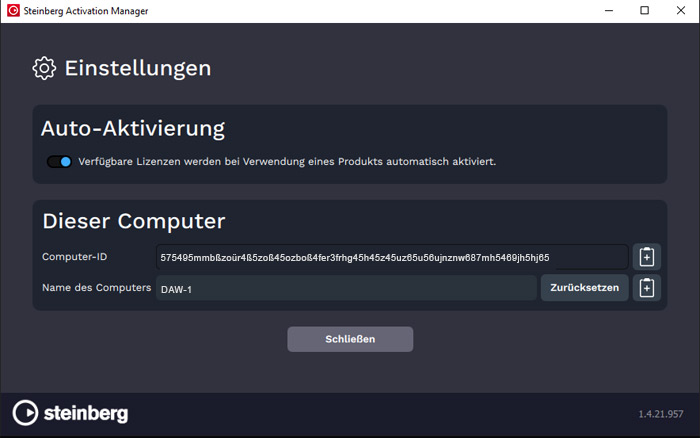Steinberg License System Change
from Dongle to Cloud Service
In 2022 Steinberg changed there product license system from the USB-eLicenser dongle to a cloud based system. The handling of the software copy protection is an important point for the users. The notation software Dorico wre the first moved to the cloud based locense sytem. Cubase and Nuendo follow up and WaveLab also in the first quarter of 2023. We had the possibility to talk to Benjamin Timms, Head of UK R&D at Steinberg Media Technologies GmbH, about the new software license system.

proaudio.de: First, the most important question. What is the reason for switching from a dongle-based, hardware licensing system to something like a cloud-based licensing system?
There are several reasons for this switch. Firstly, our users are often on the move when they’re creating music and requiring a USB dongle to be connected to your laptop is somewhat antiquated and impractical. Additionally, linking your licenses to your Steinberg ID also safeguards them against loss. Last, but not least, moving to a cloud-based system allows us to reduce our environmental impact, removing unnecessary plastic and electronic waste, as well as eliminating the environmental impact of shipping physical devices.
proaudio.de: So the Steinberg ID plays a central role? Will you also be offering multi-user accounts? For example, for educational institutions?
Yes, linking your licenses to the Steinberg ID allows users to simply sign in to activate the software. Yes, the new system will enable us to offer more flexible licensing to educational institutions. There are various flavours of multi-user licensing, and we’ll start with adding machine-based multi-user licenses in the first instance, with a floating license solution to follow. We hope to offer these features as soon as we can this year.
proaudio.de: What other advantages does the new licensing system offer?
In addition to the reasons mentioned above, managing the licenses from a central location allows us to provide more flexibility when it comes to potential future additional licensing models such as subscription, as well as the immediate benefit of allowing three activations for single user licenses.

proaudio.de: There must have been challenges when moving to the new technology, which were probably more complex than customers would appreciate. Were all the challenges successfully overcome?
Yes, our existing licensing system was embedded in many of the day-to-day processes within the company, so switching systems while keeping the existing business running was significant challenge.
Another source of complexity was the intricate set of dependencies between our large portfolio of products, requiring us to find answers to questions like “What happens if a user upgrades to Cubase 12 – with the eLicenser code removed – yet still needs to use plug-ins that cannot be rebuilt easily and still use the eLicenser?” and “How can we switch across to Steinberg Licensing without needing to recreate all our content and needing our users to redownload it all?”
Of course, there are still edge-case and product transition scenarios that prove challenging which we continue to work on with the view to retiring the eLicenser servers once we’ve answered the remaining questions.
proaudio.de: What will happen regarding the licenses of software that does not yet use the new license activation manager? When will all of Steinberg’s programs work with the new system?
With the transition of HALion 7 in February, our main product lines have switched across to Steinberg Licensing with tried-and-tested mechanisms for upgrades, grace periods and in-version switchovers now in place.
We will continue reviewing our back-catalogue of instruments and loop content and transition those over time or discontinue products which have either being superseded or reaching the end of their lifecycle.
proaudio.de: Are you planning to offer the new license management system to other providers, or will it remain exclusively for users of Steinberg software?
Our core business is making creative tools for our users, so we will be focusing on that. As we are part of the Yamaha family of companies you may see Steinberg Licensing used in some other products that aren’t made by Steinberg, but they will all still use the Steinberg ID as the main identity system and will fit naturally into the ecosystem of our products.
proaudio.de: How long will you continue to support the eLicenser technology? There are other providers who still employ the eLicenser, but surely support will end at some point?
The timeline for official support for our other providers was communicated directly to them based on our contractual relationships with each provider, so there’s no one answer there.
When it comes to the possibility of sunsetting the eLicenser system, we are still looking into options for customers to still use their software once the servers are switched off. These options, and their scalability, are dependent on the number of customers still using dongles and how many switch over to Steinberg Licensing, so it’s important to focus making the transition as easy as we can before evaluating the ways of turns out the lights for eLicenser

proaudio.de: Is it already possible - and if not, will it be possible - for a user to remove assigned devices/DAWs from their account? For example, when the SSD on the computer running the DAW is defective and it’s impossible to deactivate the license from there?
Yes, this is possible now in the Steinberg ID account web pages. If your computer is no longer accessible, you can deactivate all the licenses linked to that computer from the server-side without needing to contact our support team.
 How to resolve AdBlock issue?
How to resolve AdBlock issue?